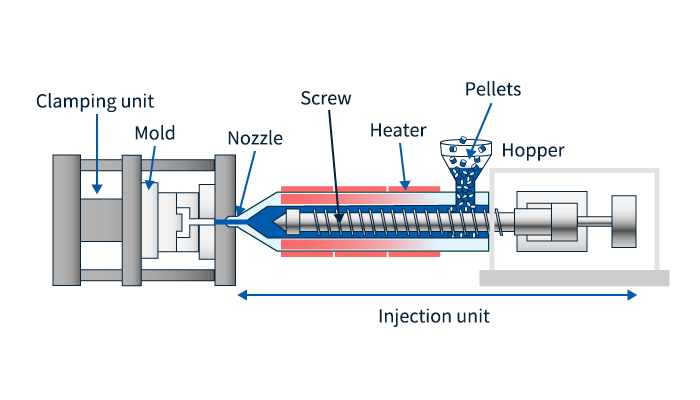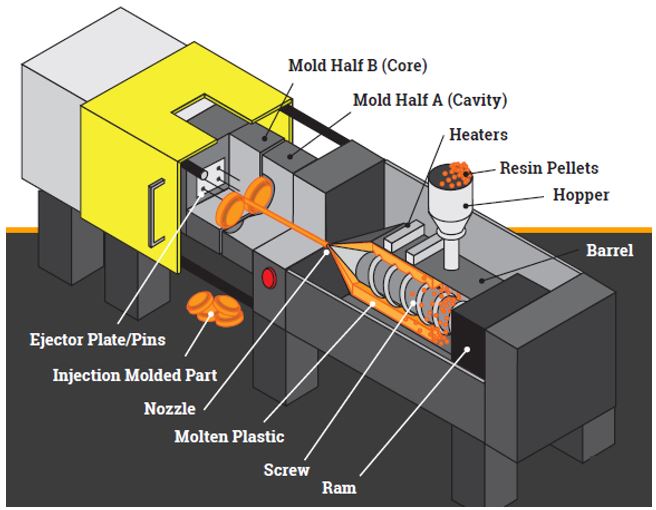Recognizing the Plastic Injection Molding Process for High-Quality Manufacturing
Recognizing the Plastic Injection Molding Process for High-Quality Manufacturing
Blog Article
Comprehending the Fundamentals of Plastic Shot Molding Procedures
Plastic shot molding offers as a keystone of contemporary production, giving a methodical method to creating intricate elements with accuracy. Checking out these crucial aspects could expose how even minor adjustments can lead to substantial renovations in manufacturing outcomes, raising concerns regarding the possibility for technology in this well-known procedure.
What Is Plastic Shot Molding?
Plastic injection molding is a widely utilized production procedure that changes thermoplastic and thermosetting materials into precise and complex forms. This method is preferred for its capacity to generate high volumes of similar parts with outstanding precision, making it a vital approach in numerous markets, consisting of auto, durable goods, and clinical devices.
The procedure entails melting the selected plastic product and infusing it right into a mold under high pressure. The mold and mildew, created to the specs of the preferred component, enables the molten plastic to materialize as it cools down and solidifies. As soon as the material has actually hardened, the mold is opened up, and the finished component is expelled.
Plastic injection molding uses numerous advantages, consisting of minimized waste, consistency in manufacturing, and the ability to include complex styles that may be testing with various other producing techniques. In addition, it sustains a broad variety of materials, each offering special homes that can be customized for particular applications. As sectors remain to introduce, plastic injection molding remains at the leading edge, enabling the growth of advanced products that fulfill evolving consumer needs.
The Injection Molding Process
The shot molding process is an advanced strategy that involves several vital stages to generate high-quality plastic parts. Plastic pellets are fed into a warmed barrel where they are melted right into a thick liquid. This molten plastic is then injected under high pressure into a precision-engineered mold, which shapes the product right into the desired type.
Once the mold and mildew is loaded, the plastic is enabled to cool down and strengthen, taking the form of the mold tooth cavity. Cooling time is critical, as it influences the cycle time and the final properties of the shaped component. After sufficient cooling, the mold and mildew opens up, and the finished element is expelled using ejector pins.

Products Made Use Of in Shot Molding
Different materials can be used in the injection molding process, each offering one-of-a-kind residential properties that accommodate specific applications. One of the most generally made use of products include thermoplastics, thermosetting plastics, and elastomers.

Thermosetting plastics, like epoxy and phenolic materials, undergo a chemical adjustment throughout the go to these guys treating procedure, resulting in a rigid, inflexible framework. These materials are optimal for applications needing high warm resistance and structural stability, commonly utilized in electric insulators and auto components.
Elastomers, consisting of silicone and rubber-based products, offer versatility and resilience. Their distinct properties make them appropriate for applications that demand elasticity, such as gaskets and seals.
In addition, specialty products like bio-based plastics and compounds are gaining grip for their environmental advantages and enhanced efficiency features, broadening the range of injection molding applications in different markets. Understanding the residential properties of these materials is important for selecting the proper kind for specific jobs.
Benefits of Shot Molding
Shot molding stands apart as a highly effective manufacturing process that supplies numerous benefits for creating intricate get rid of accuracy. Among the most considerable benefits is the capability to produce complex designs click that would certainly be impossible or challenging to accomplish with other approaches (Plastic Injection Molding). The procedure enables for in-depth functions and limited resistances, making certain premium elements
Furthermore, injection molding is recognized for its rapid production capabilities, making it a perfect selection for high-volume manufacturing. As soon as the mold and mildew is developed, parts can be generated promptly, minimizing lead times and enhancing general productivity. This effectiveness not just decreases manufacturing expenses yet also offers an one-upmanship in the market.
The convenience of products used in injection molding even more improves its charm. A wide variety of thermoplastics and thermosetting polymers can be employed, permitting makers to pick materials that ideal fulfill their particular requirements, including toughness, versatility, and warmth resistance.
In addition, the procedure reduces waste, as excess material can often be recycled and reused. This sustainability aspect contributes to a lowered ecological effect, making shot molding an accountable manufacturing option. On the whole, the advantages of injection molding make it a recommended technique for lots of sectors.
Factors Influencing Item Quality
While numerous variables can affect product high quality in injection molding, recognizing these aspects is vital for achieving optimal results. Secret elements consist of material option, refining criteria, and mold layout.
Material choice plays a vital role, as different polymers display one-of-a-kind properties that affect flowability, toughness, and thermal security. Poor product choice can cause flaws such as warping or incomplete dental filling.
Processing specifications, including temperature level, pressure, and cycle time, need to be diligently regulated. Variants in these settings can result in variances in component measurements and surface area coating. For instance, exceedingly high temperature Visit This Link levels may create destruction of the polymer, while poor stress can cause brief shots.
Mold design is just as crucial, as it establishes the flow of the molten plastic and the cooling process. Improperly created molds might result in uneven cooling rates, leading to recurring anxieties and dimensional errors.

Final Thought
To conclude, plastic shot molding functions as an important production procedure that allows the reliable manufacturing of high-quality components. Proficiency of the injection molding process, consisting of the understanding of materials and the impact of numerous elements on item top quality, is essential for accomplishing optimal results. The advantages of this technique, such as cost-effectiveness and design flexibility, additional highlight its value throughout numerous markets, solidifying its status as a favored choice for high-volume production.
Plastic injection molding offers as a cornerstone of modern production, providing a systematic strategy to generating intricate parts with precision.Plastic injection molding supplies several advantages, consisting of decreased waste, uniformity in manufacturing, and the capacity to integrate intricate designs that might be challenging with other making techniques (Plastic Injection Molding). As industries proceed to introduce, plastic injection molding stays at the center, allowing the development of innovative products that satisfy progressing consumer needs
The shot molding process is an innovative technique that involves a number of essential phases to create high-quality plastic components.In conclusion, plastic injection molding serves as a critical manufacturing process that makes it possible for the reliable manufacturing of high-grade components.
Report this page